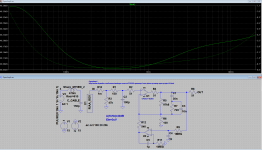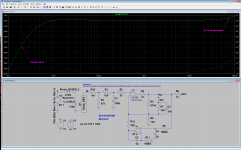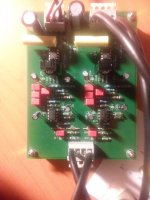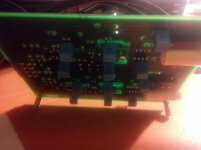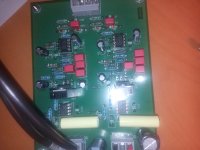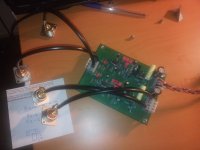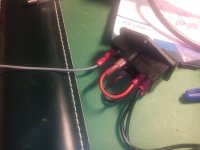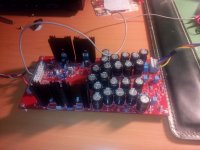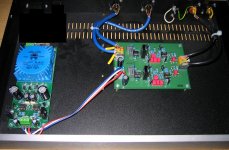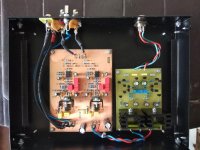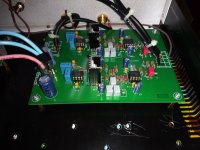i agree that openamp sounds very good. i use mine with an old borbely sulzer regulator.
folks looking for a nice mm preamp will not be disappointed.
mlloyd1
folks looking for a nice mm preamp will not be disappointed.
mlloyd1
Hello,
I simulated the circuit and noted, that the deviation from the ideal RIAA is 4.5%. Precision starts at less than 1%, for me at least.
The dusty NE5534A actually is a little bit less noisy than the OPA627 with the Shure Cartridge.
Greetings,
Udo
I simulated the circuit and noted, that the deviation from the ideal RIAA is 4.5%. Precision starts at less than 1%, for me at least.
The dusty NE5534A actually is a little bit less noisy than the OPA627 with the Shure Cartridge.
Greetings,
Udo
Attachments
Maybe an odd question, but the THD is measured at 1 Volt. Does the THD increase at 2 Volts of output?
Ah, that's nice to know.
I've completed the build, but when I turn it on I hear a rather loud pop, as well as a bit off buzz that isn't there when other amps are attached. Is this a servo problem? Or just bad grounding?
I've completed the build, but when I turn it on I hear a rather loud pop, as well as a bit off buzz that isn't there when other amps are attached. Is this a servo problem? Or just bad grounding?
This is difficult to guess at long distance. Normally the preamp is very quiet. I would guess ground loop .... or another mistake. Will you post a photo of the whole arrangement?
I've added some photo's. I've substituted the ceramic caps with polyprop (my supplier couldn't supply me with decent ceramics). These are mounted on the underside. I've also added polyprop caps on C4, C5, C104 and C105.
I was forced to remove the electrolytic caps of 10uF, and the current caps are therefore mounted on top of the board instead of fully through (they do make full contact, no cold joints).
I've temporarily swapped the OPA627 for the NE5534, because of stocking issues. I've tried to keep the BOM as stock as possible, as only the C4... etc. are a conscious choice. I haven't measured any parasitic capacitances thus far.
I've grounded the standard chassis via the ground plane of the PSU to the wall. Adding another line from X1-3 to this ground plane doesn't improve the hum. Turntable was earthed elsewhere.
The pop made me think of a DC-transient, maybe caused by faulty servos.
I was forced to remove the electrolytic caps of 10uF, and the current caps are therefore mounted on top of the board instead of fully through (they do make full contact, no cold joints).
I've temporarily swapped the OPA627 for the NE5534, because of stocking issues. I've tried to keep the BOM as stock as possible, as only the C4... etc. are a conscious choice. I haven't measured any parasitic capacitances thus far.
I've grounded the standard chassis via the ground plane of the PSU to the wall. Adding another line from X1-3 to this ground plane doesn't improve the hum. Turntable was earthed elsewhere.
The pop made me think of a DC-transient, maybe caused by faulty servos.
Attachments
I've temporarily swapped the OPA627 for the NE5534, because of stocking issues.
I've grounded the standard chassis via the ground plane of the PSU to the wall.
The pop made me think of a DC-transient, maybe caused by faulty servos.
1) NE5534 must not be used, because it is not unity gain stable. It will oscillate. Try anything with unity gain stability - OPA134 will be a good candidate.
2) There must be no external ground loop. The board should be placed into metal case, connected with metal case in one point (I use input RCA point), but the case should not be connected with wall PE protective ground. The preamp should be in class II with only 2-wire power cord. Signal ground loop must be avoided.
3) Initial thump is possible, turn on phono preamp as first and power amp as last. But first please fix (1) - the 5534 issue.
Summary - there must be no audible hum in case you use proper opamps and avoid all ground loops. Capacitor types do not affect the hum.
Power supply transformer of the preamp should not be close to the board.
Edit: please check the photo and a terminal to connect optional turntable grounding wire - if it exists.
Attachments
Last edited:
I will add to that: If I hear a "pop" when switching that indicates a DC offset somewhere, so your first step (after conforming to the BOM) should be to measure for DC on the outputs of the OpenAmp1. If there is DC there, then you have made a mistake somewhere.
I built mine to PMA's specs and have none of the problems you have mentioned.
I built mine to PMA's specs and have none of the problems you have mentioned.
Thanks Pavel! I thought the NE5534 was unity gain stable, but it seems that only the NE5532 is. Guess I mixed them up.
Both my multimeters are faulty, but it seems that there isn't any DC coming from the output (according to my least faulty meter at least below 0.5mV). Thanks for the advice anyway 🙂.
I seem to have gotten the hum out of the amp, but due to current lack of a decent chassis, it now picks up faint radio signals (it's grounded on an old radio receiver/amplifier).
Both my multimeters are faulty, but it seems that there isn't any DC coming from the output (according to my least faulty meter at least below 0.5mV). Thanks for the advice anyway 🙂.
I seem to have gotten the hum out of the amp, but due to current lack of a decent chassis, it now picks up faint radio signals (it's grounded on an old radio receiver/amplifier).
Wow! 🙂
May I ask what opamp are you using now? It should be definitely JFET input type because of the resistance against RFI, OPA134 is a decent opamp at a reasonable price and will make a good job in the OPENAMP1.
May I ask what opamp are you using now? It should be definitely JFET input type because of the resistance against RFI, OPA134 is a decent opamp at a reasonable price and will make a good job in the OPENAMP1.
I'm currently using a OP177 because I got 2 free when ordering them. I'm thinking about going with a OPA827, since it's cheaper than the OPA627, but I'll order the OPA134 in the meantime. Thanks again for the advice 🙂
OPA827 should be fine, but there is no DIP version in production, only SMD package. So, OPA134 would be easier to use for you.
OP177 is not usable (SR = 0,3V/us), just only for the first test.
OP177 is not usable (SR = 0,3V/us), just only for the first test.
Well, I finally got around to finishing the preamp. Finally able to listen to my records again!
Turns out the housekeeper broke my turntable needle, so I can't hear anything from the left side -_-
Well, it sounds pretty much noiseless when hooked up to an old iPod, and I'm using the OPA134, so there's still more room for improvement 🙂
Thanks for all the help and the design Pavel!
Turns out the housekeeper broke my turntable needle, so I can't hear anything from the left side -_-
Well, it sounds pretty much noiseless when hooked up to an old iPod, and I'm using the OPA134, so there's still more room for improvement 🙂
Thanks for all the help and the design Pavel!
Glad to hear you have successfully completed your preamp. OPA134 is fine, you can keep it. OPA627 will give you only a slight improvement in case that the needle is not in the groove yet 🙂. Once in the groove, there will be no difference, the groove noise will completely mask it.
I am sorry they are not, as I finished all audio kit sales in 2012. However, everything you need for it is published on my web page
Preamplifier for MM cartridge
Preamplifier for MM cartridge
Thank you both for the positive feedback. I am glad that the preamp works well and that you like it. IMO it shows that even with opamps we may get very good sound and profit from the buffered output.
- Home
- Source & Line
- Analogue Source
- OPENAMP1 - MM phono preamp open project
